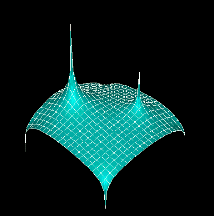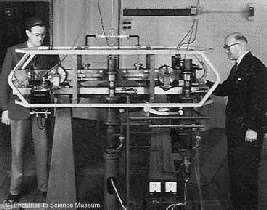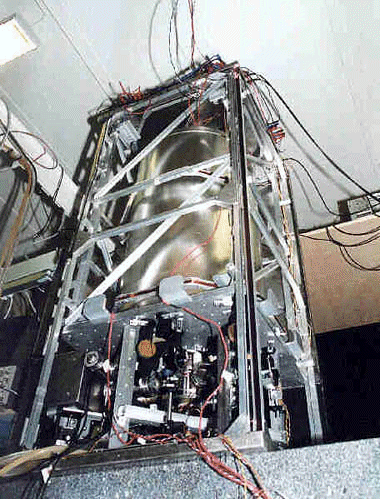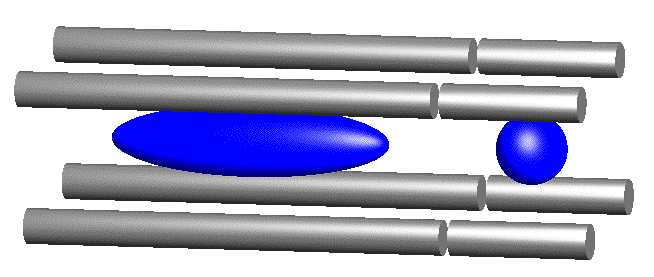






























|

The 1955 Cesium Atomic Clock at the National Physical Laboratory,
UK. It kept time to a second in 300 years.
A "cesium(-beam) atomic clock" (or "cesium-beam frequency
standard") is a device that uses as a reference the exact frequency of the
micro-
wave spectral line emitted by atoms of the metallic element cesium, in
particular its
isotope of atomic weight 133 ("Cs-133"). The integral of frequency is
time, so
this frequency,
9,192,631,770 hertz
(Hz = cycles/second), provides the fundamental
unit of time, which may thus be measured by cesium clocks.
Today, cesium clocks measure
frequency with an accuracy of from 2 to 3 parts in 10 to the 14th, i.e. 0.0002
Hz; this
corresponds to a time measurement accuracy of 2 nanoseconds per day or one
second in
1,400,000 years.
It is the most accurate realization of a unit that mankind has yet
achieved.
A cesium clock operates by exposing cesium atoms to microwaves until they
vibrate at one of their resonant frequencies and then counting the
corresponding cycles as
a measure of time. The frequency involved is that of the energy absorbed from
the incident
photons when they excite the outermost electron in a cesium atom to jump
("transition") from a lower to a higher orbit.
According to quantum theory, atoms can only exist in certain discrete
("quantized") energy states depending on what orbits about their
nuclei are
occupied by their electrons. Different transitions are possible; those in
question refer
to a change in the electron and nuclear spin ("hyperfine") energy
level of the
lowest set of orbits called the "ground state." Cesium is the best
choice of
atom for such a measurement because all of its 55 electrons but the outermost
are confined
to orbits in stable shells of electromagnetic force. Thus, the outermost
electron is not
disturbed much by the others. The cesium atoms are kept in a very good vacuum
of about 10
trillionths of an atmosphere so that the cesium atoms are little affected by
other
particles. All this means that they radiate in a narrow spectral line whose
wavelength or
frequency can be accurately determined.
In a cesium clock , liquid cesium is heated to a gaseous state in an oven. A
hole in
the oven allows the atoms to escape at high speed. These particles pass between
two
electromagnets whose field causes the atoms to separate into two beams,
depending on which
spin energy state they are in. Those in the lower energy state pass through the
ends of a
U-shaped cavity in which they are irradiated by microwaves of 3.26-cm
wavelength.
The absorption of these micro- waves excite transitions of many of the atoms
from the
lower to the higher energy state. The beam continues through another pair of
electromagnets, whose field again divides up the beam. Those atoms in the
higher energy
state strike a hot wire, which ionizes them. Thereafter, a mass spectrometer
selects only
the cesium atoms from any impurities and directs them onto an electron
multiplier.
The frequency of the microwaves is adjusted until the electron multiplier output
current is maximized, constituting the measurement of the atoms'
resonance frequency
.
This frequency is elctronically divided down and used in a feedback control
circuit
("servo-loop") to keep a quartz crystal oscillator locked to a
frequency of 5
megahertz (MHz), which is the actual output of the clock, along with a
one-pulse-per-second signal. The entire apparatus is shielded from external
magnetic
fields.
The first method for accurately measuring hyperfine frequencies by molecular
beam
resonance was developed by I.I. Rabi and his associates in 1937 at Columbia
University.
The first molecular clock, using ammonia gas, was built by H. Lyons at the
National Bureau
of Standards in 1949. The first atomic clock, a cesium-beam frequency standard,
was built
starting in 1949 and was first operated in 1951, resulting in the first direct
measurements of cesium hyperfine frequencies. The clock, called NBS-1, was the
first in a
series that is now up to 7 (NBS is now the National Institute of Standards and
Technology,
so their latest standard is called NIST-7). Between 1953 and 1955, L. Essen and
J.V.L.
Parry of the National Physical Laboratory (NPL) in Teddington, England built
cesium atomic
clock. These atomic clocks were later refined by others, notably N.F. Ramsey
and J.R.
Zacharias, and are the primary standards referred to above.
The first atomic clock timescale was established in 1955 at NPL, though it
differed
signicantly from the astronomical ephemeris timescale established by Dr. William
Markowitz, head of Time Service at the U.S. Naval Observatory. Markowitz and
Essen
collaborated on the determination of a best value for the cesium hyperfine
frequency, and
in 1958 they reported a value of 9,192,631,770 hertz (cycles/second).
The Second
In 1967, the 13th General Conference on Weights and Measures first defined the
International System (SI) unit of time, the second, in terms of atomic time
rather than
the motion of the Earth. Specifically, a second was defined as
the duration of
9,192,631,770 cycles of microwave light absorbed or emitted by the hyperfine
transition of
cesium-133 atoms in their ground state undisturbed by external fields
.
The first commercial atomic frequency standards were built by R. Daly of
National
Company and J. Holloway of Varian Associates. Their cesium tube design was
incorporated by
L. Cutler and his coworkers at Hewlett-Packard in what would become the largest
selling
series of commercial standards.
Recent improvements in cesium clock technology include replacement of the
state-selection magnets with laser beams, which can select and detect the
required
transition with greater efficiency and less motion of, and hence less noise
from, the
radiating atoms. A new appraoch is being explored called the Cesium Fountain.
|
Cesium
Atomic Fountain Frequency Standards
The atomic fountain works by first cooling
cesium atoms to microKelvin temperatures by means of an "optical
molasses"
generated from 6 laser beams (two counter-propagating beams in each of the
three cardinal
directions), tuned to a frequency slightly below the 852 nanometer optical
resonance.
Atoms are then launched upwards by altering the frequency of the lasers. The
launched
atoms travel vertically from their trapping region, are prepared into the
|3,0> state,
and then they continue through a microwave cavity containing a field tuned to
the 9192 MHz
hyperfine frequency of the cesium atom (set by the energy difference between
the |4,0>
and |3,0> states). They continue moving upwards until the Earth's gravity
causes them
to fall back through the microwave cavity, where they again interact with the
microwave
field. The two exposures to the microwave field will cause some atoms to make
the
transition from the |3,0> state to the |4,0> state. The atoms then pass
through two
state detection regions where the number of atoms in the two states are
measured by
detecting scattered laser light.
The true frequency of the 9192 MHz microwave field can be inferred from the
percentage
of atoms that made the transition from the |3,0> state to |4,0> state.
The most
important advantage in precision (stability on the short-term, seconds to
hours) of such a
clock over conventional cesium frequency standards is that more precise
frequency
measurements can be made over the long (1/2-second) travel time between the two
exposures
to the microwave field. One important advantage in accuracy (stability with
respect to all
sources of error, not just short-term measurement-noise) comes from the fact
that the
interaction with the microwave field occurs in the same cavity each time,
resulting in the
cancellation of certain systematic effects. Another advantage is that the
velocity of the
atoms is so slow that the second-order Doppler shift (time dilation) is
negligible.

The atomic cesium fountain (1.2m high) is the first frequency standard
using cold cesium atoms. Cesium atoms are cooled to a few micro Kelvin and they
are
launched one meter high. They follow a parabolic flight, passing twice through
a single
microwave cavity. The long time between the two interactions leads to a
sub-Hertz Ramsey
resonance, 100 times narrower than the Ramsey fringes obtained in conventional
cesium
frequency standards.

How Trapped Ions Can Be Used to Make a Clock
Ions can be used to set the frequency of a microwave signal, and frequencies
can be
converted to time by simple addition. To see how this works, you must realize
that if you
have a periodic signal of known frequency "f", all you need to do is
find a way
to count anything that occurs once per period, and one second will be of
"f" of
them. This is why the most precise clocks are more accurately referred to as
frequency
standards. For example, if you had a voltage that went up and down past zero
once each
period, you could measure a second by counting the passage of "f"
maxima,
minima, upward-going zero crossings, or downward-going zero crossings. A
specific example
could be a pendulum clock. If you know that it goes back and forth every 4
seconds, then
all you have to do is count the number of times it goes all the way to the
right and
multiply by 4 to get the number of seconds that have gone by. Of course, in
practice such
counting is not always so simple. Also, if the frequency is large it is usually
necessary
to subtract the frequency of interest from a second frequency, which yields a
measurement
of only the difference between two frequencies.
Ions (ionized atoms) can absorb and re-emit radiation at certain very specific
frequencies. By trapping the ions, they can interact for several seconds with
microwaves
whose frequency can be varied so as to be "exactly" equal to, or
offset by a
known amount from, that frequency which the ions can absorb and re-emit. The
longer the
ions can interact with the microwave frequency without being disturbed, the
more precisely
they can distinguish between microwaves at the resonant frequency which they
most strongly
absorb and those at slightly different frequencies. In the case of mercury,
this resonant
microwave frequency is 40,507.348 MHz, which is subtracted from a similar
frequency
generated from the Master Clock. As described above, this frequency difference
can be
summed to convert into a time difference between the mercury clock and the
Master Clock.
The Technique of Trapping Ions
It is well known that ions can be trapped in an oscillating quadrupole field,
which is
dramatized in the graphic above. As the ions move back and forth in response to
the
changing electrical force, it can be shown that they experience a net inward
force, called
the pondermotive force. Because about one million ions are trapped, this
attractive force
is balanced by the mutual repulsion of like charges, so that the resulting
density of
mercury ions is largely confined to and approximately uniform within a radius
of 2.5
millimeters.
By using such a force field to trap mercury ions and the technique known as
optical
pumping to prepare the state of the mercury ions, it is possible to tune an
input 40.5 GHz
microwave field so that its frequency matches the natural frequency of the
trapped
mercury. Measurements of this tuned frequency forms the basis of a clock. It
can be shown
that the intrinsic accuracy of such a clock is chiefly affected by the
second-order
Doppler effect of the ionic motions (also known as time dilation).
HYDROGEN MASER CLOCKS
Masers are atomic clocks which have outstanding short-term stability. USNO's
current
Sigma Tau
hydrogen masers [STSC Model 2010(1994)] exhibit a
time domain
maximum instablility
of 3.0 parts in 10 the 15th for periods of 1000 to 10,000 seconds
and 2.0 parts in 10 to the 13th * t**-(3/5) for 1 sec < t < 1000 sec.
The drift is specified at initially less than 1 part in 10 to the 15th per day.
The USNO
Sigma Tau masers NAV-2,3,4, and 5 have shown drifts of less than a part in 10
to the
16th/day over 500 days.
These hydrogen masers are 46 x 76 x 109 cm in size and with batteries weigh 227
kg.
The main components of a hydrogen maser are the
hydrogen gas supply
, a
controllable "leak" for the gas into the
high vacuum system
, a
gas
discharge
to produce atomic hydrogen, and a
state selector
which rejects atoms
in the lower energy states and focusses the higher states into the
storage bulb
.
A small storage bottle supplies molecular hydrogen to the gas discharge bulb.
In the
discharge bulb, molecules of hydrogen are dissociated into atomic hydrogen.
They then pass
through a source collimator and a magnetic state selector which filters atoms
at the
desired atomic state and passes them to the resonance cavity.
The storage bulb is a quartz bulb about 20 cm tall which is coated inside with
Teflon
to control the recombination rate of atoms into molecules. The quartz bulb is
located in a
precisely machined pure copper cylinder which acts as a microwave resonant
cavity for the
1.420 GHz frequency of the 21 cm hydrogen line. Once the atoms enter the
resonance cavity,
they find other atoms radiating and they fall in step. They "start to talk
to each
other" and echo what they hear. This produces a highly coherent
oscillation. This is
the signal to which the crystal oscillator is phase-locked. All of that is
packaged in
cabinets with power supplies, temperature control, and magnetic shielding.
Great care is required to keep environmental disturbances small so that the full
performance potential of these sophisticated clocks can be realized.
|

